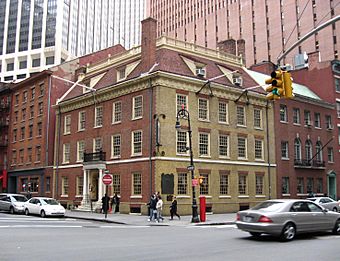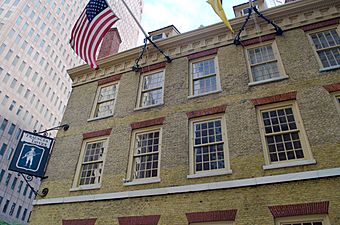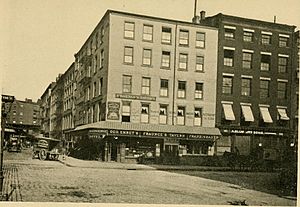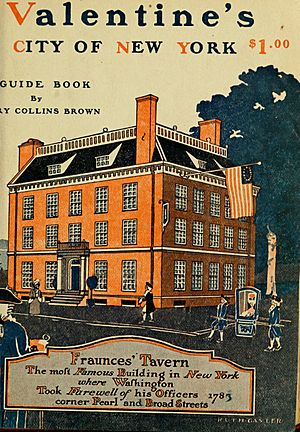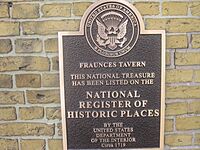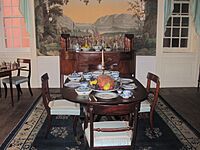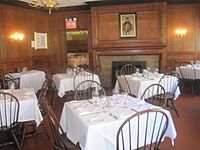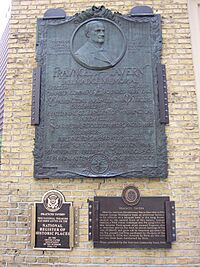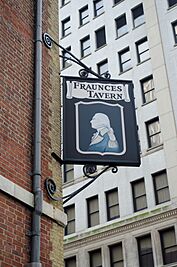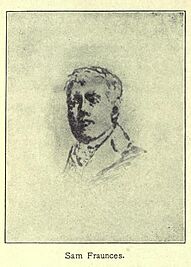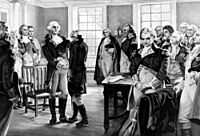Fraunces Tavern facts for kids
Fraunces Tavern is a famous building in New York City. It serves as both a museum and a restaurant today. You can find it at 54 Pearl Street in the Financial District of Lower Manhattan. This place played a very important role in American history, especially during and after the American Revolution.
Over the years, Fraunces Tavern was a headquarters for George Washington. It was also a place where peace talks happened with the British. For a time, it even housed early United States government offices. Since 1904, the Sons of the Revolution in New York State have owned the tavern. They believe it is Manhattan's oldest building still standing. The museum inside teaches visitors about the building's past. It also has many art pieces and historical items. Fraunces Tavern is a popular spot for tourists. It is part of the American Whiskey Trail and the New York Freedom Trail. It is recognized as a National Historic Place and a New York City designated landmark. The entire block where it stands is also a special historic district.
Contents
Fraunces Tavern: A Historic Spot
Early Days of the Tavern
In 1671, New York Mayor Stephanus van Cortlandt built his home on this very spot. Later, in 1700, he gave the land to his son-in-law, Étienne "Stephen" DeLancey. Stephen DeLancey was a French Huguenot (a type of Protestant).
DeLancey built the current building as a house in 1719. The small yellow bricks used to build it came all the way from the Dutch Republic (modern-day Netherlands). It was a very grand house for its time. In 1762, DeLancey's family sold the building to Samuel Fraunces. He turned the house into a popular tavern. It was first called the Queen's Head.
A Meeting Place for Patriots
Before the American Revolution, Fraunces Tavern was a secret meeting spot for the Sons of Liberty. This group of Patriots wanted freedom from British rule. During the "tea crisis" in 1773, caused by the British Tea Act, Patriots made a British ship captain apologize publicly at the tavern. Then, like those at the Boston Tea Party, they dressed as American Indians and dumped the ship's tea into New York Harbor.
In 1768, the New York Chamber of Commerce was started at a meeting in the building. Also, in 1771, the first meeting for what is now NewYork-Presbyterian Hospital took place here.
During the American Revolution
In August 1775, American students from King's College (now Columbia University) took cannons from the southern tip of Manhattan. They fired at a British ship called HMS Asia. The British ship fired back, and a cannonball went right through the tavern's roof!
In September 1780, a farmer named Jane Tuers visited the tavern. She heard British soldiers toasting General Benedict Arnold. They were celebrating his plan to give West Point to the British. Tuers quickly shared this information. Her news helped confirm what General Washington already suspected. This led to the arrest and punishment of Arnold's partner, John André, and stopped the plot. Arnold later joined the British side.
As the war was ending, the tavern hosted meetings between British and American leaders. They discussed what would happen to formerly enslaved people who had gained their freedom by helping the British. A British officer, Brigadier General Samuel Birch, kept records of these people. This record was called the Book of Negroes. It helped ensure that many Black loyalists could leave with the British troops if they wished.
Washington's Farewell to His Officers

Engraving after painting by Alonzo Chappel
|
|
| Date | December 4, 1783 |
|---|---|
| Location | Fraunces Tavern, Broad and Pearl Streets, New York Town |
A week after British troops left New York on November 25, 1783, a special dinner was held at the tavern. On December 4, 1783, General George Washington said goodbye to his officers from the Continental Army. He told them, "With a heart full of love and gratitude, I now take leave of you." He then shook hands with each officer.
After the Revolution
In January 1785, New York City became the first capital of the United States. This was under the Articles of Confederation. Important government offices, like those for Foreign Affairs, Finance, and War, were located at Fraunces Tavern.
When the United States Constitution was approved in 1789, these offices became federal departments. George Washington became the first President of the United States in April 1789. However, in 1790, the capital moved to Philadelphia, Pennsylvania. The federal offices then left Fraunces Tavern and moved to Philadelphia.
Fraunces Tavern in Later Years
The building continued to operate through the 1800s. It had several serious fires, starting in 1832. Because it was rebuilt many times, its original look changed quite a bit. After a big fire in 1852, two more stories were added, making it five stories tall. In 1890, the main bar area was lowered to street level. The old wooden beams were even sold as souvenirs!
Saving and Rebuilding
By 1900, the owners planned to tear down the tavern. They wanted to use the land for a parking lot. Many groups, especially the Daughters of the American Revolution, worked hard to save it. They convinced New York state leaders to protect the building.
In 1904, the Sons of the Revolution in New York State bought the property. Much of the money came from Frederick Samuel Tallmadge. He was the grandson of Benjamin Tallmadge, who was George Washington's main spy during the Revolution. A major rebuilding project finished in 1907. It was led by William Mersereau, an early expert in saving historic buildings. At the time, people called the tavern "the most famous building in New York."
Some historians say that Mersereau's rebuilding was more of a guess than an exact copy. They say he used other old buildings as a guide. So, the building you see today might not look exactly like the original 1719 house.
In 1965, the building was named a landmark by the New York City Landmarks Preservation Commission. The whole city block around it was also made a landmark district in 1978. The National Park Service added the block to the National Register of Historic Places in 1977. The building itself was added to the Register in 2008.
A Difficult Event
| Fraunces Tavern bombing | |
|---|---|
| Location | Manhattan, New York, U.S. |
| Date | January 24, 1975 |
|
Attack type
|
bombing |
| Weapons | bomb |
| Deaths | 4 |
|
Non-fatal injuries
|
50+ |
| Perpetrators | FALN |
| Assailant | Unknown |
On January 24, 1975, a bomb exploded inside the tavern. Four people died, and more than 50 were hurt. A group called the FALN (Armed Forces of Puerto Rican National Liberation) said they were responsible. They had carried out other bombings in New York in the 1970s. No one has been charged for this bombing.
Fraunces Tavern Today
| Established | December 4, 1907 |
|---|---|
| Location | 54 Pearl Street, New York, NY |
| Visitors | 25,000 |
| Owner | Sons of the Revolution in the State of New York, Inc. |
| Public transit access | Bus: M15 Subway: |
Since 1907, the Fraunces Tavern Museum has been on the second and third floors. It helps tell the story of the tavern and its historical items. The museum has nine different rooms or galleries. These include a collection of paintings about the American Revolution. There's also a gallery with portraits of George Washington.
The "Long Room" is where General George Washington had his famous farewell dinner. The "Clinton Room" looks like a dining room from the early days of the United States. Other galleries show the history of the Sons of the Revolution. There are also spaces for special exhibits. For example, in 2014, the museum showed 27 old maps from the 1700s and 1800s.
The building was also the office for the General Society, Sons of the Revolution until 2002. The Fraunces Tavern Museum still has galleries about the Revolution. This includes the "McEntee Sons of the Revolution" Gallery.
Gallery
-
National Register of Historic Places marker from the U.S. Dept. of the Interior
-
George Clinton Room at the Fraunces Tavern museum
See also
 In Spanish: Taberna Fraunces para niños
In Spanish: Taberna Fraunces para niños
- List of the oldest restaurants in the United States
- List of National Historic Landmarks in New York City
- List of New York City Designated Landmarks in Manhattan below 14th Street
- National Register of Historic Places listings in Manhattan below 14th Street
- List of the oldest buildings in New York


